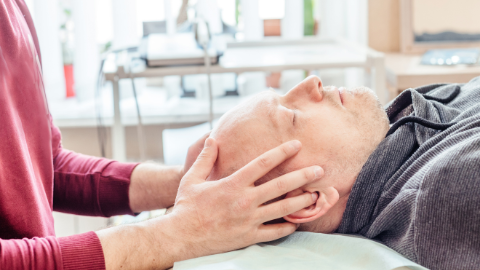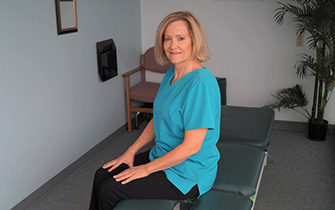Most people are familiar with massage as a safe way to relieve muscle tension, soreness, and pain in the body — but there’s another treatment option that offers many of the same benefits and is even less invasive. You may have heard the term “Craniosacral” therapy, but you may not know what it is.

What is craniosacral therapy?
Craniosacral therapy (CST) is a subtle yet powerful manual therapy that focuses on the craniosacral system—comprising of the membranes and fluid that surround and protect your brain and spinal cord. This gentle treatment involves light touch to detect restrictions in the craniosacral rhythm and release tension in the central nervous system.
Our skilled therapists use precise, feather-light pressure (typically about the weight of a nickel) to identify and release restrictions in the craniosacral system. This treatment encourages your body’s natural healing mechanisms to improve whole-body function.
How does craniosacral therapy work?
CST helps restore your body’s rhythm by gently supporting the natural movement of cerebrospinal fluid (CSF), which flows between your brain and spine. When stress or trauma disrupts this flow, it can cause pain, tension, and dysfunction.
Using soft touch, your therapist identifies these disruptions and facilitates release through subtle manual techniques. This allows your body to self-correct and return to a more balanced state.
Craniosacral therapy benefits
People turn to craniosacral therapy for a wide range of reasons. Some of the most common benefits include:
- Reduced tension and chronic pain
- Better sleep and relaxation
- Improved focus and mental clarity
- Fewer headaches and migraines
- Relief from stress and anxiety
Many clients also report feeling calmer and more grounded after treatment. Feel the difference for yourself—contact us today and experience the benefits firsthand.
What conditions can craniosacral therapy treat?
CST is a natural way to heal your body, and helps many people who suffer from long-term chronic pain and many more conditions. Just like with massage therapy, it’s an all-around good treatment, but it can be especially effective for other conditions like:
- Migraines and headaches
- Muscle and joint pain
- Stress and tension
- Neck and back pain
- Colic and sleeping disorders in babies
- Chronic fatigue syndrome
- TMJ Disorder
- Post-traumatic stress disorder (PTSD)
- Whiplash
- Post-concussion symptoms
- Sleep disturbances
- Certain neurological conditions
- Infantile conditions like colic, feeding difficulties, and sleep problems
- Fibromyalgia
- Vertigo and dizziness
- Recovery from surgery or physical trauma
It’s especially helpful for those with nervous system-related conditions or who are unable to tolerate deeper manual therapies.
Craniosacral therapy for children
Cranialsacral therapy can be particularly beneficial for children, including infants. This gentle technique may help with:
- Colic and feeding difficulties
- Sleep disturbances
- Sensory processing challenges
- Recovery from birth trauma
Our therapists use extremely gentle approaches when working with young clients, ensuring a comfortable and safe experience.
Craniosacral therapy for pregnancy and postpartum
Pregnancy and postpartum bring major changes to your body—physically, hormonally, and emotionally. Craniosacral therapy offers gentle, hands-on support to help you feel more balanced through it all.
During pregnancy, it may help:
- Ease back and pelvic pain
- Improve sleep
- Reduce stress and muscle tension from postural shifts
Postpartum, this therapy supports healing after birth. It can:
- Aid pelvic alignment
- Release stored tension from delivery
- Support your nervous system as you recover
Our therapists create a calm, supportive environment where you can rest, recover, and reconnect with your body.
What to expect during a session
At Summit Physiotherapy, our craniosacral practitioners are fully certified and experienced in this specialized manual therapy technique. Your treatment begins with a comprehensive assessment to understand your health concerns and establish baseline craniosacral rhythm patterns.
During your session:
- You’ll remain fully clothed while lying comfortably on a treatment table.
- The therapist will use gentle touch—primarily on your head, spine, and sacrum—to evaluate and enhance the movement of cerebrospinal fluid through your central nervous system.
Most clients report feeling deeply relaxed during treatment, often experiencing:
- A sensation of gentle pulsing
- Warmth
- A feeling of tissue release
Some notice immediate improvements, while others see gradual changes over several sessions.
Meet Our Craniosacral Therapy Specialist
Frequently Asked Questions
People often have questions about CST as it’s not as common as traditional massage therapy and there are much fewer therapists that are trained to perform it. We’ve answered some of the questions clients have before receiving a treatment for the first time.
Who can get craniosacral therapy?
Everybody, really. Craniosacral therapy can treat a variety of ailments, making it valuable for many people. It’s also a great maintenance treatment. In our opinion, it’s often best to have a team of people to help you care for your body. It’s not likely that one type of treatment will meet all of your needs for your entire life. It’s more common to see clients utilizing multiple therapies such as massage, physiotherapy, and craniosacral therapy.
What can a patient expect from their first craniosacral treatment?
It’s very relaxing! While massage really focuses on muscle work, craniosacral therapy focuses on connective tissue, which ends up being a lighter pressure. Technically, it’s considered a hands-on treatment, but it’s a very non-invasive hands-on treatment. Craniosacral therapy is gentle, making it a very appropriate treatment for anyone and is especially comfortable for children, seniors, and people who are very sensitive to touch.
How will I feel after a craniosacral treatment?
You’ll feel relaxed, as you would after a massage. However, with massage therapy, people can walk away feeling worked on, and they might feel sore the next day. Craniosacral therapy is less invasive, so it’s less likely to cause soreness afterward. It’s a very easy treatment for the body to absorb.
How often can I receive craniosacral therapy?
While you can get a full-body massage every three or four days for the rest of your life, you’ll need much longer between craniosacral sessions. We recommend a minimum of two to three weeks in between treatments, so your body can process them.
Can you receive massage and craniosacral therapy at the same time?
Yes. The combination of both the muscle work (in massage therapy) and connective tissue work (in craniosacral therapy) is the perfect combination.
What’s the difference between craniosacral therapy and massage?
While both treatments promote relaxation and healing, they work in different ways. Massage therapy primarily targets muscle tissue using moderate to deep pressure to address muscle tension and improve circulation. Craniosacral therapy uses very light touch (about 5 grams of pressure) to influence the fluid system surrounding your brain and spinal cord. It focuses on the central nervous system rather than muscles directly. Many clients benefit from receiving both therapies as part of a comprehensive treatment plan.
Is craniosacral therapy evidence-based?
While research on craniosacral therapy is still evolving, studies have shown promising results for certain conditions, particularly headaches, migraines, and neck pain. The therapy is based on osteopathic principles and has been developed through clinical observation and practice. Many clients report significant symptom improvement, though individual results vary. At Summit Physiotherapy, we combine this approach with evidence-based physiotherapy techniques to provide comprehensive care.
Ready to book your craniosacral therapy treatment?
For more information, or to book your consultation, call us today or book an appointment online.

